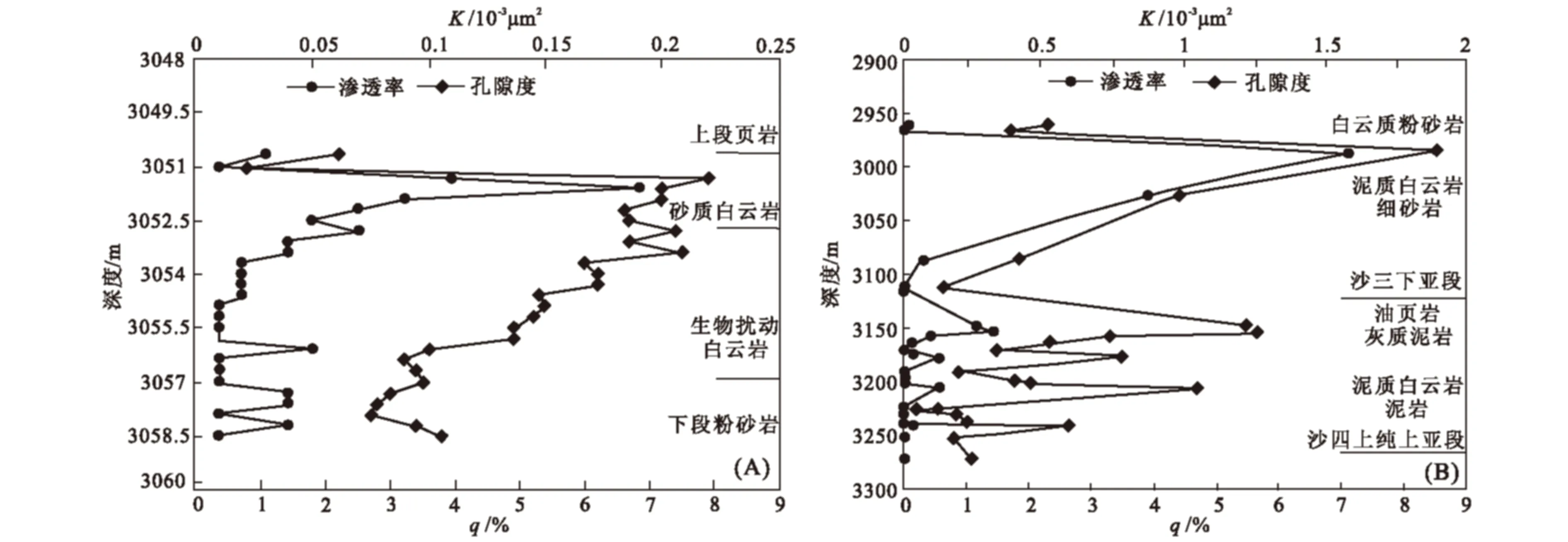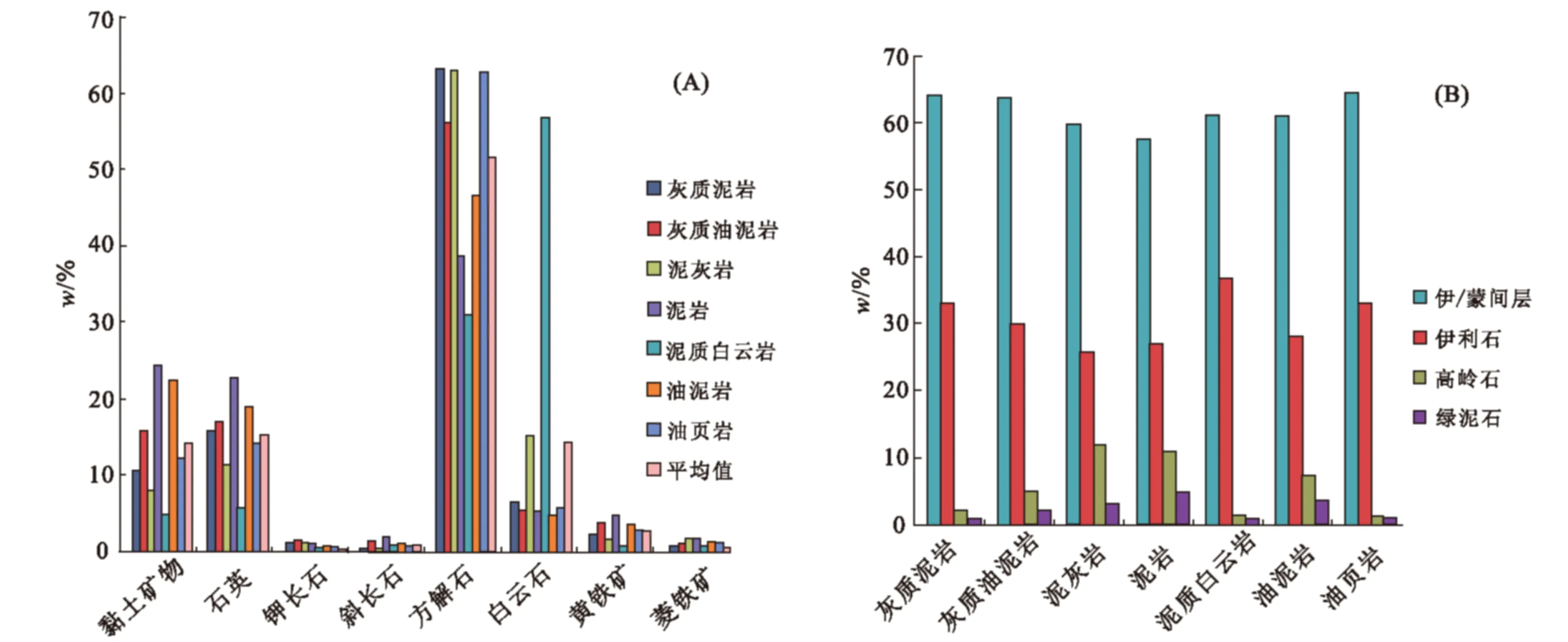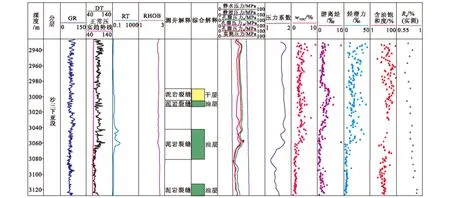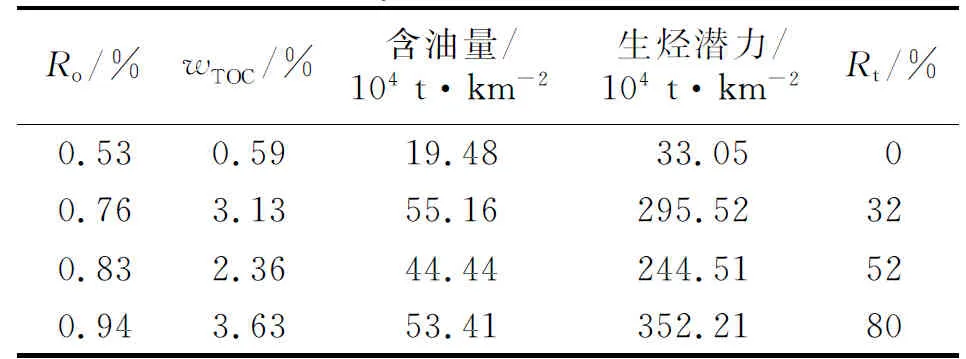济阳拗陷沙河街组页岩与美国Bakken组页岩储层“甜点”特征对比
陈美玲, 潘仁芳, 张超谟, 沈禄银
(长江大学 油气资源与勘探技术教育部重点实验室,武汉 430100)
济阳拗陷沙河街组页岩与美国Bakken组页岩储层“甜点”特征对比
陈美玲, 潘仁芳, 张超谟, 沈禄银
(长江大学 油气资源与勘探技术教育部重点实验室,武汉 430100)
从源岩到储层的思路,探讨济阳拗陷沙河街组页岩和美国Bakken组页岩储层特征和形成机理。通过对Bakken组和沙河街组页岩有机地球化学分析、岩性分析、储层物性分析和矿物学分析,表明沙河街组页岩储层“甜点”特征为:有机质以Ⅰ型干酪根为主;wTOC>2.36%,Ro为0.76%~0.90%;主要为纹层状泥灰岩、泥质白云岩、灰质泥岩、油泥岩和油页岩;孔隙度>3%,渗透率<0.5×10-3μm2;脆性矿物质量分数>20%;含油饱和度为60%~90%;储层厚度为13.60~90 m;储层主要为沙三下亚段。对比Bakken有利页岩储层地质特征表明,Bakken组页岩储层“甜点”特征为:有机质以Ⅰ型干酪根为主;wTOC>5.36%,Ro为0.51%~0.72%;砂质白云岩;孔隙度>3%,渗透率<0.1×10-3μm2;脆性矿物质量分数>50%;含油饱和度为50%~71%;储层厚度为3.10~12.20 m;Bakken中段为优质储层段。沙河街组和Bakken组页岩储层形成的机理主要为有利的矿物组合和普遍发育的超压。
济阳拗陷;威利斯顿盆地;沙河街组;Bakken组;页岩油;储层特征
随着世界能源需求的增加,页岩气勘探和开发不断深入发展,与此同时,世界很多地区已经发现页岩油,展示了巨大的资源潜力[1-5]。美国是最早从页岩气转移到页岩油勘探和生产的国家,中国页岩油的开发刚刚起步。北美学者认为页岩油是指储存在富有机质泥岩或页岩和邻近贫有机质碳酸盐岩夹层中的石油[2]。国内大多数学者认为页岩油是指以吸附或游离态赋存于纳米级孔喉和裂缝中的石油,或是邻近的致密碳酸盐岩夹层的储集层中,未经过长距离运移的连续型石油聚集,是中国未来非常规石油发展的潜在领域[6-10]。
美国威利斯顿盆地Bakken组和中国渤海湾盆地古近系沙河街组页岩均以富有机质烃源岩和低孔隙度-渗透率储层为特征,二者皆为非常规连续型石油聚集[11-17]。美国地质调查局对Bakken页岩可恢复资源潜力调研表明,Bakken组页岩资源潜力约36.5亿桶[18,19],是北美页岩油最具远景的页岩层系。截至2015年,美国已经在威利斯顿盆地Bakken组钻遇约5 000口井[19],取得了显著的勘探开发成效。中国东部陆相页岩分布面积广、厚度大、有机质热演化处于生油高峰阶段,渤海湾盆地沙河街组页岩油资源潜力为(20.5~25.4)×108t[20,21]。截至2013 年底,济阳拗陷300余口探井在沙河街组页岩中见油气显示,其中30余口井获工业油气流[21],预示着沙河街组有较大的页岩油勘探前景,有必要对沙河街组页岩储层“甜点”特征展开研究(图1)。

图1 济阳拗陷页岩油钻井分布图Fig.1 Distribution of shale oil drilling wells in Jiyang depression
国内学者对志留系龙马溪组页岩储层研究后,认为页岩储层形成机理主要为岩性、有利的矿物组合和有机质热裂解[22,23];闫德宇等对海陆过渡相页岩研究后,指出矿物岩石特征是页岩储层形成和保存条件之一[24];大部分学者认为页岩储层发育的主控因素为有利的沉积环境和有机地化特征[25-29]。但是,目前针对中国东部沙河街组页岩储层“甜点”特征和储层形成机理尚未涉及。笔者在充分调研Bakken组页岩储层特征以及最新勘探开发的基础上,依据分析测试数据、测井数据和岩性数据对中国东部济阳拗陷古近系沙河街组页岩储层“甜点”特征进行研究,通过对比Bakken组和沙河街组页岩烃源岩分布、储集岩性、储集空间、储层厚度、储层物性、储层分布和质量,最终探讨沙河街组和Bakken组页岩储层的形成机理。
1 液态烃比较
“甜点”是指钻井的地层或深度层段最具有勘探潜力的页岩远景区,表现为2种不同的方式:①识别盆地内含油最好的地理区域;②识别完井段最好的地质层段。许多研究者认为页岩储层“甜点”是含油远景区或者是具有经济潜力的可生产区域,其目标是综合识别优质储层特征(有机质类型、有机碳含量、有机质成熟度、储层厚度、含油地质储量、孔隙度和渗透率)[8,30,31]。
沙河街组页岩为陆相沉积背景,分布较稳定,有机质以Ⅰ型干酪根为主,总有机碳质量分数(wTOC)值范围大,一般为0.41%~9.32%;有机质热演化程度较低,有机质成熟度Ro值为0.45%~0.94%(表1)。Bakken组页岩为海相沉积背景,分布稳定,有机质以Ⅰ型干酪根为主,wTOC值为5.36%~24.70%;有机质热演化程度低,Ro值为0.53%~1.30%,主要集中在0.51%~0.72%[5](表1)。
沙河街组页岩储层非均质性极强,受陆源碎屑影响大,页岩储层孔隙度相对较低,测井孔隙度峰值集中在3%~7%,以发育微孔为主。Bakken组页岩储层非均质性相对较弱,受陆源碎屑影响较小,页岩孔隙度相对较高,测井孔隙度一般在5%~10%。
沙河街组页岩主要分布在凹陷的众多次级洼陷,页岩厚度大,储层厚度为13.60~90.00 m,分布范围广、面积大,含油饱和度为27.80%~122.40%,平均值为27.80%,可动液态烃部分相对较低。Bakken组页岩主要分布于背斜-穹窿带,为陆棚滨岸沉积环境,页岩厚度小,储层厚度为3.10~12.20 m,含油饱和度为10%~71%,平均值为51%,可动液态烃部分相对较高[13]。
沙河街组陆相页岩地层经历了较强烈复杂的晚期构造运动,影响页岩的保存条件;超压发育,压力系数为1.21~1.81;凹陷地区地温梯度较低,一般为0.20~0.45℃/km[32];主力烃源岩层深度为2.8~5.1 km,液态烃多为中质油。Bakken组海相页岩构造稳定,保存条件好,超压发育;地温梯度较低,一般为0.25~0.34℃/km;主力烃源岩层深度为2.5~3.25 km,液态烃多为轻质油[33]。
2 储层特征对比
2.1Bakken组页岩
Bakken组上段和下段富有机质页岩发育,广 泛分布于整个盆地(图2-A)。Bakken组中段发育粉砂质白云岩,北部变薄,可容纳空间增加导致厚度变化[13]。Bakken组中段发育的生物扰动白云岩和砂质白云岩为优质储层岩性,是水平井主要目的层段(图3-A)。Bakken组中段测井孔隙度(q)为1%~8%,渗透率(K)为(0.03~0.20)×10-3μm2(图3-A)。Bakken组中段产油层深度为2 593~3 203 m,有效厚度>4.30 m。Bakken组储集空间类型以粒间孔和晶间孔为主,储层质量向上改善,普遍发育超压(图2-A)[13]。

表1 沙河街组与Bakken组储层特征对比Table 1 Comparison of reservoir characteristics of shale oil between Shahejie Formation and Bakken Formation
2.2沙河街组页岩
目前针对济阳拗陷东营-沾化凹陷非常规油储层研究仍然处于初级探索阶段,而在东营-沾化凹陷勘探井中古近系获得工业油流,是近几年中国东部非常规油气勘探的突破之一。
济阳拗陷古近系储集层主要集中在沙三下亚段,岩性组合主要为深灰色灰质泥岩、深灰色(灰褐色)灰质油泥岩、灰色泥灰岩、深灰色泥岩和灰色泥质白云岩(图2-B)。研究区牛52井沙河街组页岩测井孔隙度为0.10%~8.60%,渗透率为(0.001~1.601)×10-3μm2(图3-B)。沙河街组页岩油储集层空间以晶间孔、溶蚀孔和裂缝为主, 有机质孔较少[17,34](表1)。一般地,沙河街组页岩油井储集层空间主要为泥岩裂缝型或是Ⅰ/Ⅱ/Ⅲ级页岩裂缝型,储层质量向上改善(图2-B)。与Bakken组页岩储层相比,研究区沙河街组储层表现为岩性多样,页岩裂缝发育,且非均质性较强(图2-B)。
东营-沾化凹陷5口页岩油井沙河街组岩心物性统计结果表明:①有91%的样品孔隙度>3%,孔隙度峰值为3%~7%;渗透率<5×10-3μm2的样品占78%,其中有49%样品渗透率<0.05×10-3μm2(图4)。②埋藏较深,成岩作用强,发育部分次生孔隙。③含油饱和度高。④储层非均质性强,岩性多样,粒度细,黏土矿物含量高,裂缝发育。⑤地层压力高。其中:①孔隙度为0.10%~13.38%,平均值为4.33%,以低孔为主,少量中孔,无高孔特征(图4-A)。②渗透率为(0.001~22.934)×10-3μm2,表现为低渗特征(图4-B)。

图2 页岩油井测井特征图Fig.2 Well logging characteristics for shale oil well(A) Bakken组页岩[5];(B)义186井沙河街组页岩

图3 页岩油井孔隙度渗透率特征图Fig.3 The characteristics of porosity and permeability for shale oil well(A)44-24 Vaira 井Bakken组中段[14];(B)牛52井沙河街组页岩
结合济阳拗陷页岩储层特征,可将其分为2类:Ⅰ类储集层,孔隙度为8%~12%,渗透率为(1.22~22.93)(10-3μm2,以油迹、荧光粉砂岩为主;Ⅱ类储集层,孔隙度为3%~8%,渗透率为(0.01~1.59)×10-3μm2,以油斑泥灰岩、灰质泥岩、灰质油泥岩和油页岩为主。

图4 沙河街组页岩孔隙度与渗透率分布直方图Fig.4 Histogram showing porosity and permeability for Shahejie Formation shale
沙河街组和Bakken组页岩油产层对比,总体上共性大于个性(表1)。差异较大的几点是总有机碳含量、储集岩性、储层厚度、储层物性和储层分布层段。
整体上,沙河街组页岩wTOC为2.36%~9.32%,储集岩性主要为泥灰岩、泥质白云岩、灰质泥岩、灰质油泥岩、泥岩和油页岩,页岩油储集空间以粒间孔、晶间孔和裂缝为主。储层厚度为13.60~90.00 m,储集性能整体表现为低孔、低渗、高压力、基质渗透率极低、致密特征,以Ⅱ类储层为主(表1),储层主要分布在沙三下亚段。
Bakken组wTOC为5.36%~24.70%,储集岩性主要为生物扰动白云岩和砂质白云岩,储集空间以粒间孔、晶间孔和裂缝为主。储层厚度为3.10~12.20 m,储集性能整体表现为低孔、低渗、普遍发育超压、基质渗透率极低、致密特征,以Ⅱ类储层为主(表1),储层主要分布在Bakken组中段。
3 页岩储层形成机理对比
3.1有利的矿物组合
页岩的矿物组成和有机质热演化是页岩储层发育的重要因素[1]。X射线衍射分析结果表明,沙河街组页岩油产层主要矿物的质量分数分别为:石英平均为18.17%,长石平均为1.40%,方解石平均为51.92%,白云石平均为6.17%,黄铁矿平均为3.81%,另有少量的菱铁矿(图5-A);黏土矿物平均为18.89%,以伊蒙混层和伊利石为主,未见蒙脱石(图5-B)。Bakken组页岩油产层主要矿物的质量分数分别为:石英为52%,长石为9%,白云石为21%~70%(平均为38%),黄铁矿为9%,黏土矿物为17%[4],上段和下段碳酸盐平均值分别为10%和6%。脆性矿物含量控制页岩的裂缝体积,黏土矿物含量影响页岩的吸附能力[22]。研究区沙河街组石英含量不及Bakken组,方解石含量较高,黏土矿物含量相近;wTOC为0.71%~9.32%,平均值为3.10%(图6)。因此,在沙河街组页岩储层中,溶蚀孔和黏土矿物晶间孔较发育,有机质孔以发育微孔为主。

图5 罗69井沙河街组页岩矿物含量直方图Fig.5 Histogram showing shale mineralogic and clay mineralogic content of the Shahejie Formation rocks in Well Luo-69(A)页岩矿物含量直方图;(B)黏土矿物含量直方图

图6 罗69井沙河街组页岩储层压力综合图Fig.6 Comprehensive map showing shale reservoir pressure of Shahejie Formation in Well Luo-69
3.2有机质热演化
从研究区5口重点探井——义187井、义186井、义182井、牛52井和梁758井沙河街组岩石热解地化参数和岩心统计结果来看,沙河街组页岩绝大部分Ro值>0.76%,处于生油高峰阶段。有机质热演化与转换率(Rt)的关系研究表明(表2),Ro值为0.76%时,沙河街组页岩已经发生排烃,牛52井深度为3 279.50~3 306.00 m、义187井深度为3 453.00~3 688.00 m的生烃潜力(S2×21.89)、含油量(S1×21.89)和排烃效率分别为(223.50×104t/km2, 295.52×104t/km2),(25.83×104t/km2, 55.16×104t/km2),(88%,81%)。Jarvie等对Barnett页岩的研究认为高的排烃效率,不仅为页岩油的富集创造良好的生油条件,而且有利于改造页岩储层的孔隙度和渗透率[1]。
研究区沙河街组与Bakken组页岩相比,差异最大的是有机质转换率。北部Dakota地质研究表明,Bakken组页岩Ro值为0.51%~0.72%,有机质以Ⅰ型干酪根为主,有机质裂解程度低,有机质转换率低于沙河街组[5]。沙河街组 页岩同一深度段的游离烃S1值比S2值更小,这含油量=S1×21.89; 烃潜力=S2×21.89[1]。

表2 沙河街组页岩有机质转换率Table 2 Organic matter transformation ratios for Shahejie Formation shale
代表处于低成熟度的有机质转换为油气(图6)。由此可见,有机质转换率能够有效地预测沙河街组页岩生油和排烃窗。
3.3普遍发育的超压
超压有利于页岩油的富集和保存,高产页岩油往往具有超压[35]。根据钻井资料对30口井沙河街组非常规页岩储层压力的预测表明,沙河街组页岩储层普遍发育超压。以沾化凹陷罗69井为例,计算的压力系数为1.21~1.82,预测的压力与实测地层压力吻合较好(图6)。罗69井沙河街组泥岩裂缝层段,孔隙流体压力增加,这就解释了为什么沙河街组页岩普遍发育异常压力缝,主要超压成因机制为欠压实和有机质生烃增压[34,36,37](图6)。沙河街组页岩Ro值为0.70%~0.93%,处在油气的生成和保存期,这就使得生油岩热解产生较大的S2值(图6)。
H. Løseth等对富有机质页岩变形构造研究表明油气产量与异常压力之间存在着相关关系[38],一般地,超压带往往具有较高的含油饱和度,且超压的页岩油气储层需要识别“甜点”,而低压储层本身具有可生产性,不需要识别储层“甜点”[39]。沙河街组页岩与Bakken组页岩储层对比,二者均普遍发育超压。
4 结 论
a. 对比研究区沙河街组与Bakken组页岩储层“甜点”特征,明确两者存在共性与差异。沙河街组页岩储层“甜点”特征是有机质以Ⅰ型干酪根为主,wTOC>2.36%,Ro为0.76%~0.90%,主要岩性为纹层状泥灰岩、泥质白云岩、灰质泥岩、油泥岩和油页岩,孔隙度>3%,渗透率<0.5×10-3μm2,脆性矿物的质量分数>20%,含油饱和度为60%~90%,储层厚度为13.60~90.00 m,储层分布于沙三下亚段。说明研究区沙河街组具有高产油的地质条件。
b. Bakken组页岩储层“甜点”特征是有机质以Ⅰ型干酪根为主,wTOC>5.36%,Ro为0.54%~0.71%,砂质白云岩,孔隙度>3%,渗透率<0.1×10-3μm2,脆性矿物的质量分数为50%,含油饱和度为50%~71%,储层厚度为3.10~12.20 m,中段为优质储层段。Bakken组页岩是典型的连续型石油聚集。
c. 页岩储层的形成机理主要为有利的矿物组合、有机质热演化和普遍发育的超压。沙河街组和Bakken组页岩共同的储层形成机理主要为有利的矿物组合和普遍发育的超压。
[1] Jarvie D M, Hill R J, Ruble T E,etal. Unconventional shale-gas systems: The Mississippian Barnett Shale of north-central Texas as one model for thermogenic shale-gas assessment [J]. AAPG Bulletin, 2007, 91(4): 475-499.
[2] Jarvie D M. Shale resource systems for oil and gas: Part 2-shale-oil resource systems[J]. AAPG Memoir, 2012, 97: 89-119.
[3] Wolela A. Sedimentation, organic maturity, and petroleum potential of the Oligocene-Miocene oil shale deposits, Yayu Basin, southwestern Ethiopia [J]. AAPG Bulletin, 2010, 94(5): 643-663.
[4] Kuhn P P, Primio R D, Hill R,etal. Three-dimensional modeling study of the low-permeability petroleum system of the Bakken Formation [J]. AAPG Bulletin, 2012, 96(10): 1867-1897.
[5] Jarvie D M, Coskey R J, Johnson M S,etal. The geology and geochemistry of the Parshall area, Mountrail County, North Dakota[J]. Rocky Mountain Association of Geologists, 2011, 7: 1-39.
[6] 贾承造,邹才能,李建忠,等.中国致密油评价标准、主要类型、基本特征及资源前景[J].石油学报,2012,33(3):343-350.
Jia C Z, Zou C N, Li J Z,etal. Assessment criteria, main types, basic features and resource prospects of the tight oil in China[J]. Acta Petrolei Sinica, 2012, 33(3): 343-350. (In Chinese)
[7] 邹才能,杨智,崔景伟,等.页岩油形成机制、地质特征及发展对策[J].石油勘探与开发,2013,40(1):14-26.
Zou C N, Yang Z, Cui J W,etal. Formation mechanism, geological characteristics and development strategy of nonmarine shale oil in China [J]. Petroleum Exploration and Development, 2013, 40(1): 14-26. (In Chinese)
[8] 邹才能,杨智,张国生,等.常规-非常规油气“有序聚集”理论认识及实践意义[J].石油勘探与开发,2014,41(1):14-27.
Zou C N, Yang Z, Zhang G S,etal. Conventional and unconventional petroleum “orderly accumulation”: Concept and practical significance[J]. Petroleum Exploration and Development, 2014, 41(1): 14-27. (In Chinese)
[9] 邹才能,陶士振,白斌,等.论非常规油气与常规油气的区别和联系[J].中国石油勘探,2015,20(1):1-16.
Zou C N, Tao Z Z, Bai B,etal. Differences and relation between unconventional and conventional oil and gas[J]. China Petroleum Exploration, 2015, 20(1): 1-16. (In Chinese)
[10] 张金川,林腊梅,李玉喜,等.页岩油的分类与评价[J].地学前缘,2012,19(5):322-331.
Zhang J C, Lin L M, Li Y X,etal. Classification of evaluation shale oil[J]. Earth Science Frontiers, 2012, 19(5): 322-331. (In Chinese)
[11] Smith M G, Bustin R M. Late Devonian and early Mississippian Bakken and Exshaw black shale source rocks, western Canada sedimentary basin: A sequence stratigraphic interpretation[J]. AAPG Bulletin, 2000, 84(7): 940-960.
[12] Kuhn P P, Primio R D, Hill R,etal. Three-dimensional modeling study of the low-permeability petroleum system of the Bakken Formation[J]. AAPG Bulletin, 2012, 96(10): 1867-1897.
[13] Chen Z H, Osadetz K G, Jiang C Q,etal. Spatial variation of Bakken or Lodgepole oils in the Canadian Williston Basin[J]. AAPG Bulletin, 2009, 93(6): 829-851.
[14] Sonnenberg S A, Pramudito A. Petroleum geology of the giant Elm Coulee field, Williston Basin[J]. AAPG Bulletin, 2009, 93(9): 1127-1153.
[15] 贾承造,郑民,张永峰.中国非常规油气资源与勘探开发前景[J].石油勘探与开发,2012,39(2):129-136.
Jia C Z, Zheng M, Zhang Y F. Unconventional hydrocarbon resources in China and the prospect of exploration and development[J]. Petroleum Exploration and Development, 2012, 39(2): 129-136. (In Chinese)
[16] 王永诗,王伟庆,郝运轻,等.济阳拗陷沾化凹陷罗家地区古近系沙河街组页岩储集特征分析[J].古地理学报,2013,15(5):657-662.
Wang Y S, Wang W Q, Hao Y Q,etal. Shale reservoir characteristics analysis of the Paleogene Shahejie Formation in Luojia area of Zhanhua sag, Jiyang Depression[J]. Journal of Palaeogeography, 2013, 15(5): 657-662. (In Chinese)
[17] 王永诗,李政,巩建强,等.济阳拗陷页岩油气评价方法----以沾化凹陷罗家地区为例[J].石油学报,2013,34(1):83-91.
Wang Y S, Li Z, Gong J Q,etal. Discussion on an evaluation method of shale oil and gas in Jiyang depression: A case study on Luojia area in Zhanhua sag[J]. Acta Petrolei Sinica, 2013, 34(1): 83-91. (In Chinese)
[18] Pollastro R M, Roberts L N R, Cook T A. Geologic model for the assessment of technically recoverable oil in the Devonian-Mississippian Bakken Formation, Williston Basin [J]. AAPG Memoir, 2012, 97: 205-257.
[19] Gaswirth S B, Marra K R. U.S. Geological Survey 2013 assessment of undiscovered resources in the Bakken and Three Forks Formations of the U.S. Williston Basin Province[J]. AAPG Bulletin, 2015, 99(4): 639-660.
[20] 张善文,张林晔,李政,等.济阳拗陷古近系页岩油气形成条件[J].油气地质与采收率,2012,19(6):1-5.
Zhang S W, Zhang L Y, Li Z,etal. Formation conditions of Paleogene shale oil and gas in Jiyang depression[J]. Petroleum Geology and Recovery Efficiency, 2012, 19(6): 1-5. (In Chinese)
[21] 张林晔,李钜源,李政,等.北美页岩油气研究进展及对中国陆相页岩油气勘探的思考[J].地球科学进展,2014,29(6):700-711.
Zhang L Y, Li J Y, Li Z,etal. Advances in shale oil/gas research in North America and considerations on exploration for continental shale oil/gas in China[J]. Advances in Earth Science, 2014, 29(6): 700-711. (In Chinese)
[22] 刘树根,马文辛,LUBA Jansa,等.四川盆地东部地区下志留统龙马溪组页岩储层特征[J].岩石学报,2011,27(8):2239-2252.
Liu S G, Ma W X, Luba J,etal. Characteristics of the shale gas reservoir rocks in the Lower Silurian Longmaxi Formation, east Sichuan Basin, China[J]. Acta Petrologica Sinica, 2011, 27(8): 2239-2252. (In Chinese)
[23] 陈文玲,周文,罗平,等.四川盆地长芯1井下志留统龙马溪组页岩气储层特征研究[J].岩石学报,2013,29(3):1073-1086.
Chen W L, Zhou W, Luo P,etal. Analysis of the shale gas reservoir in the Lower Silurian Longmaxi Formation, Changxin-1 well, Southeast Sichuan Basin, China[J]. Acta Petrologica Sinica, 2013, 29(3): 1073-1086. (In Chinese)
[24] 闫德宇,黄文辉,张金川.鄂尔多斯盆地海陆过渡相富有机质泥页岩特征及页岩气意义[J].地学前缘,2015,22(6):197-206.
Yan D Y, Huang W H, Zhang J C,etal. Characteristics of marine-continental transitional organic-rich in the Ordos Basin and its shale gas significance[J]. Earth Science Frontiers, 2015, 22(6): 197-206. (In Chinese)
[25] 黄磊,申维.页岩气储层孔隙发育特征及主控因素分析以上扬子地区龙马溪组为例[J].地学前缘,2015,22(1):374-384.
Huang L, Shen W. Characteristics and controlling factors of the formation of pores of shale gas reservoir: A case study from Longmaxi Formation of the Upper Yangtze region, China[J]. Earth Science Frontiers, 2015, 22(1): 374-384. (In Chinese)
[26] 武景淑,于炳松,张金川,等.渝东南渝页1井下志留统龙马溪组页岩孔隙特征及其主控因素[J].地学前缘,2013,20(3):260-269.
Wu J S, Yu B S, Zhang J C,etal. Pore characteristics and controlling factors in the organic-rich shale of the Lower Silurian Longmaxi Formation revealed by samples from a well in southeastern Chongqing[J]. Earth Science Frontiers, 2013, 20(3): 260-269. (In Chinese)
[27] 康志宏,周磊,任收麦,等.柴北缘中侏罗统大煤沟组七段泥页岩储层特征[J].地学前缘,2015,22(4):265-276.
Kang Z H, Zhou L, Ren S M,etal. Characteristics of shale of the 7th member of the Middle Jurassic Dameigou Formation in Northern Qaidam Basin[J]. Earth Science Frontiers, 2015, 22(4): 265-276. (In Chinese)
[28] 李娟,于炳松,夏响华,等.黔西北地区上二叠统龙潭组泥页岩储层特征[J].地学前缘,2015,22(1):301-311.
Li J, Yu B S, Xia X H,etal. The characteristics of the Upper Permian shale reservoir in the northwest of Guizhou Province, China[J]. Earth Science Frontiers, 22(1): 301-311. (In Chinese)
[29] 杨超,张金川,唐玄,等.鄂尔多斯盆地陆相页岩微观孔隙类型及对页岩气储渗的影响[J].地学前缘,2013,20(4):240-250.
Yang C, Zhang J C, Tang X,etal. Microscopic pore types and its impact on the storage and permeability of continental shale gas, Ordos Basin[J]. Earth Science Frontiers, 2013, 20(4): 240-250. (In Chinese)
[30] Bust V K, Majid A A, Oletu J U,etal. The petrophysics of shale gas reservoirs: technical challenges and pragmatic solutions[J]. Petroleum Geoscience, 2013, 19: 91-103.
[31] Romero A M, Philp R P. Organic geochemistry of the Woodford Shale, southeastern Oklahoma: How variable can shales be?[J]. AAPG Bulletin, 2012, 96(3): 493-517.
[32] 龚育龄,王良书,刘绍文,等.济阳拗陷地温场分布特征[J].地球物理学报,2003,46(5):652-658.
Gong Y L, Wang L S, Liu S W,etal. Distribution characteristics of geotemperature field in Jiyang depression, Shandong, North China[J]. Chinese Journal of Geophysics, 2003, 46(5): 652-658. (In Chinese)
[33] 杨智,侯连华,陶士振,等.致密油与页岩油形成条件与“甜点区”评价[J].石油勘探与开发,2015,42(5):1-11.
Yang Z, Hou L H, Tao S Z,etal. Formation condition and “sweet spot” evaluation of tight oil and shale oil[J]. Petroleum Exploration and Development, 2015, 42(5): 1-11. (In Chinese)
[34] 李超,朱筱敏,朱世发,等.沾化凹陷罗家地区沙三下段泥页岩储层特征[J].沉积学报,2015,33(4):795-808.
Li C, Zhu X M, Zhu S F,etal. Shale reservoir characteristics of the lower 3th member of Shahejie Formation, Luojia area, Zhanhua sag[J]. Acta Sedimentologica Sinica, 2015, 33(4): 795-808. (In Chinese)
[35] 赵文智,李建忠,杨涛,等.中国南方海相页岩气成藏差异性比较与意义[J].石油勘探与开发,2016,43(4):499-510.
Zhao W Z, Li J Z, Yang T,etal. Geological difference and its significance of marine shale gases in South China[J]. Petroleum Exploration and Development, 2016, 43(4): 499-510. (In Chinese)
[36] 宋国奇,徐兴友,李政,等.济阳拗陷古近系陆相页岩油产量的影响因素[J].石油与天然气地质,2015,36(3):463-471.
Song G Q, Xu X Y, Li Z,etal. Factors controlling oil production from Paleogene shale in Jiyang depression[J]. Oil & Gas Geology, 2015, 36(3): 463-471. (In Chinese)
[37] 宁方兴.济阳拗陷页岩油富集主控因素[J].石油学报,2015,36(3):465-471.
Ning F X. The main control factors of shale oil enrichment in Jiyang depression[J]. Acta Petrolei Sinica, 2015, 36(3): 465-471. (In Chinese)
[38] Løseth H, Wensaas L, Gading M. Deformation structures in organic-rich shales[J]. AAPG Bulletin, 2011, 95(5): 729-747.
[39] Schmoker J W. Resource-assessment perspectives for unconventional gas systems[J]. AAPG Bulletin, 2002, 86(11): 1993-1999.
Comparison of “sweet spots” characteristics of shale oil reservoir rocks between Shahejie Formation in China and Bakken Formation in North America
CHEN Mei-ling, PAN Ren-fang, ZHANG Chao-mo, SHEN Lu-yin
KeyLaboratoryofExplorationTechnologiesforOilandGasResourcesofEducation,YangtzeUniversity,Wuhan430100,China
The characteristics and formation mechanism of the shale oil reservoir rocks in the Shahejie Formation and Bakken Formation shale are discussed. Geochemical analysis, lithology analysis, reservoir petrophysics analysis and mineralogical analysis show that the characteristics of sweet spots of shale oil features for the Shahejie Formation are as follows:①The organic matter is dominated by typeⅠ-kerogen; ②Total organic carbon is large than 2.36%, withRoranging from 0.76% to 0.90%; ③Reservoir is composed of laminated argillaceous limestone, argillaceous dolomite, limestone mudstone, oil mudstone and oil shale; ④The porosity is larger than 3% and permeability is less than 0.5×10-3μm2; ⑤Brittle minerals content is over 20%; ⑥Oil saturation is in the range of 60%~90%; ⑦shale thickness ranges from 13.60 m to 90.00 m; ⑧The reservoir rocks for the petroleum system are lower of the 3rd of Shahejie Formation. Similarly, the sweet spots of excellent reservoirs in Bakken are characterized by ①The organic matter is predominantly typeⅠ-kerogen; ②Total organic carbon>5.36%, withRoranging from 0.51% to 0.72%; ③Sandy dolostone has the best reservoir properties; ④Porosity >3% and permeability <0.1×10-3μm2; ⑤ Brittle minerals content>50%, ⑥ Oil saturation is in the range of 50%~71%; ⑦ Shale thickness ranges from 3.10 m to 12.20 m; ⑧ The middle member is excellent reservoir rocks. The formation mechanism of the Shahejie Formation and Bakken shale reservoirs includes favorable mineral composition and extensive development of overpressure.
Jiyang depression; Williston Basin; Shahejie Formation; Bakken Formation; shale oil; reservoir characteristics
10.3969/j.issn.1671-9727.2016.04.07
1671-9727(2016)04-0438-09
2016-04-30。
国家重点基础研究发展计划(973)项目(2014CB239100)。
陈美玲(1986-),女,博士研究生,研究方向:非常规油气资源评价, E-mail:chenmll@126.com。
TE132.2
A

